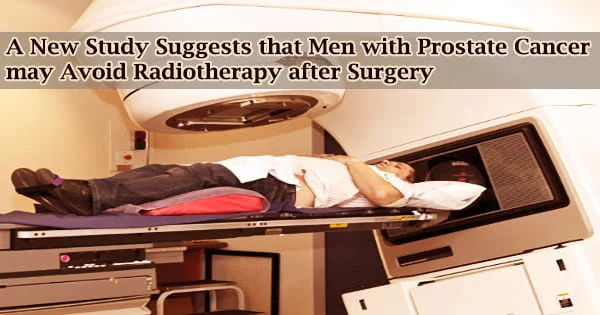According to late-breaking results of the RADICALS-RT trial presented at the ESMO Congress 2019 in Barcelona, Spain, men with prostate cancer can avoid radiotherapy following surgery. The research answers a long-standing question of whether the benefits of post-surgery radiation exceed the risks.
RADICALS-RT is the largest postoperative radiation trial in prostate cancer ever conducted. There was no difference in disease recurrence at five years between men who had radiotherapy soon after surgery and men who received radiotherapy later if cancer returned.
Study first author Prof Chris Parker, The Royal Marsden NHS Foundation Trust and Institute of Cancer Research, London, UK said:
“The results suggest that radiotherapy is equally effective whether it is given to all men shortly after surgery or given later to those men with recurrent disease. There is a strong case now that observation should be the standard approach after surgery and radiotherapy should only be used if cancer comes back.”
“The good news is that in the future, many men will avoid the side-effects of radiotherapy,” added Parker. “These include urinary leakage and narrowing of the urethra, which can make urination difficult. Both are potential complications after surgery alone, but the risk is increased if radiotherapy is used as well.”
The findings were validated in a joint meta-analysis reported at the ESMO Congress 2019, which combined the results of RADICALS with the data of two other trials, RAVES, and GETUG-AFU17.
Author of the analysis, Dr. Claire Vale, MRC Clinical Trials Unit, University College London, UK, said: “Results of the ARTISTIC meta-analysis confirm those of RADICALS, and provide greater evidence to support the routine use of observation and early salvage radiotherapy.”
“The meta-analysis provides the best opportunity to assess whether adjuvant radiotherapy may still have a role in some groups of men, and to investigate longer-term outcomes,” added Vale.
The results suggest that radiotherapy is equally effective whether it is given to all men shortly after surgery or given later to those men with recurrent disease. There is a strong case now that observation should be the standard approach after surgery and radiotherapy should only be used if cancer comes back.
Prof. Chris Parker
Commenting on the data, Dr Xavier Maldonado, Hospital Universitari Vall d’Hebron, Barcelona, said:
“These are the first results to suggest that postoperative radiotherapy for prostate cancer could be omitted or delayed in some patients. This will shorten the duration of treatment for these patients and allow better use of resources since today’s radiotherapy is technically sophisticated and therefore expensive. However, strict follow-up will be needed to identify patients requiring salvage radiotherapy.”
Longer follow-up is required for the major goal of RADICALS-RT, which is independence from distant metastases after 10 years, as well as complete reporting on toxicities, according to Maldonado.
In terms of future research, Maldonado believes the focus should be on determining whether patients still require adjuvant radiotherapy to avoid a local relapse and probable metastasis.
“We need to develop genomic classifiers to help decide the best management strategy for each patient whether it should include surgery and/or radiotherapy, and at which time points,” he said.
Results of RADICALS-RT
RADICALS-RT (NCT00541047) enrolled 1,396 patients from the United Kingdom, Denmark, Canada, and Ireland who had undergone prostate cancer surgery. Men were randomly assigned to either postoperative radiation or observation only, with radiotherapy as a backup plan if the disease recurred.
Progress-free survival was 85 percent in the radiation group and 88 percent in the standard care group after a median follow-up of five years (hazard ratio (HR) 1.10; 95 percent confidence interval (CI) 0.81-1.49; p=0.56).
At one year, 5.3 percent of patients undergoing radiation had worse urine incontinence than 2.7 percent of patients receiving conventional care (p=0.008). At any time, 8 percent of the radiotherapy and standard care groups reported grade 3/4 urethral stricture, compared to 5% of the radiotherapy and standard care groups, respectively (p=0.03).
To report on survival and the primary outcome of independence from distant metastases, a longer follow-up is required.
Results of the ARTISTIC meta-analysis
Three randomized studies comparing adjuvant radiotherapy with early salvage radiotherapy following prostatectomy for males with localized prostate cancer were included in the ARTISTIC collaborative meta-analysis: RADICALS (ISRCTN40814031), GETUG-AFU 17 (NCT00667069), and RAVES (NCT00860652). Before the trials’ outcomes were known, the analysis was planned.
The findings are based on all 2,151 men who took part in the three studies, with 1,074 receiving adjuvant radiotherapy and 1,077 receiving early salvage radiotherapy. Of those, 395 (37%) have started salvage treatment thus far.
In comparison to early salvage radiation, there was no evidence that adjuvant radiotherapy increases event-free survival (HR 1.12; 95 percent CI 0.88-1.42; p=0.37). (4) According to these findings, the difference in five-year event-free survival is estimated to be less than 1%.
















